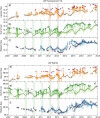Abrupt warming and salinification of intermediate waters interplays with decline of deep convection in the Northwestern Mediterranean Sea
- PMID: 33262416
- PMCID: PMC7708500
- DOI: 10.1038/s41598-020-77859-5
Abrupt warming and salinification of intermediate waters interplays with decline of deep convection in the Northwestern Mediterranean Sea
Abstract
The Mediterranean Sea is a hotspot for climate change, and recent studies have reported its intense warming and salinification. In this study, we use an outstanding dataset relying mostly on glider endurance lines but also on other platforms to track these trends in the northwestern Mediterranean where deep convection occurs. Thanks to a high spatial coverage and a high temporal resolution over the period 2007-2017, we observed the warming (+0.06 [Formula: see text]C year[Formula: see text]) and salinification (+0.012 year[Formula: see text]) of Levantine Intermediate Water (LIW) in the Ligurian Sea. These rates are similar to those reported closer to its formation area in the Eastern Mediterranean Sea. Further downstream, in the Gulf of Lion, the intermediate heat and salt content were exported to the deep layers from 2009 to 2013 thanks to deep convection processes. In 2014, a LIW step of +0.3 [Formula: see text]C and +0.08 in salinity could be observed concomitant with a weak winter convection. Warmer and more saline LIW subsequently accumulated in the northwestern basin in the absence of intense deep convective winters until 2018. Deep stratification below the LIW thus increased, which, together with the air-sea heat fluxes intensity, constrained the depth of convection. A key prognostic indicator of the intensity of deep convective events appears to be the convection depth of the previous year.
Conflict of interest statement
The authors declare no competing interests.
Figures






References
-
- Lascaratos A, Nittis K. A high resolution 3-d numerical study of intermediate water formation in the levantine sea. J. Geophys. Res. 1998;1031:18497–18512. doi: 10.1029/98JC01196. - DOI
-
- Nadia P, Masetti E. Variability of the large scale general circulation of the mediterranean sea from observations and modelling: A review. Palaeogeogr. Palaeoclimatol. Palaeoecol. 2000;158:153–173. doi: 10.1016/S0031-0182(00)00048-1. - DOI
-
- Millot C, Taupier-Letage I. Circulation in the Mediterranean Sea. Hanb. Environ. Chem. 2005;5K:29–66. doi: 10.1007/b107143. - DOI
-
- Testor, P. & Gascard, J.-C. Post-convection spreading phase in the northwestern mediterranean sea. Deep Sea Res. Part I Oceanogr. Res. Papers869–893. 10.1016/j.dsr.2006.02.004 (2006).
-
- Menna M, Poulain P-M. Mediterranean intermediate circulation estimated from argo data in 2003–2010. Ocean Sci. 2010;6:331–343. doi: 10.5194/os-6-331-2010. - DOI
Publication types
LinkOut - more resources
Full Text Sources

